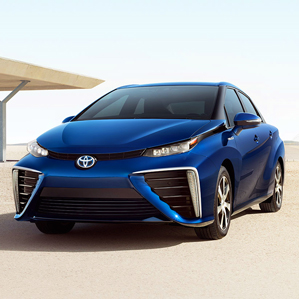Can Hydrogen Cars Become Cleaner?
Hydrogen cars, known for spitting water rather than pollutants from their tailpipes, are finally hitting the market. Toyota started selling its Mirai in Japan this month and will expand to other countries next year. Other manufacturers are showing interest, too: Hyundai is leasing hydrogen-powered SUVs; General Motors and Honda are developing their own versions.

The cars are powered by the chemical reaction that occurs when hydrogen reacts with oxygen in a fuel cell. However, making the hydrogen fuel isn’t necessarily a clean process. Hydrogen is the most common element in the universe, but it is always found bound with other elements and needs to be isolated to be used as fuel. Today, 95 percent of hydrogen produced in the United States is made by using steam to break it out of natural gas, according to the Department of Energy. That produces so much carbon dioxide that emissions related to hydrogen cars are higher than those from a hybrid gasoline car (see “Forget Hydrogen Cars, and Buy a Hybrid”).
Electrolysis—the process of splitting water into hydrogen and oxygen with an electrical current—can be cleaner, depending on the source of the electricity. For now, though, it is prohibitively expensive because the necessary catalysts are made out of costly materials such as platinum. Scientists have found some success with cheaper catalysts, but the trade-off is lower efficiency that can ultimately make the whole process of producing the hydrogen fuel more expensive.
Nonetheless, some projects are showing progress. Here are some ways that producing hydrogen fuel could become cheaper and more environmentally friendly.
Avoiding platinum
Stanford researchers have shown that electrolysis can work with electrodes made out of inexpensive nickel and nickel oxide. The device would have to be improved so that the electrodes, which now last just days, could last for weeks or months. Stanford professor Hongjie Dai says the team is in discussion with companies about scaling up the technology and estimates it could be commercialized in the next three to five years. An August article in Nature Communications gives more details about the device, and Dai explains how it works in this video.
Carbon catalyst
Rutgers scientists have designed a different catalyst that could replace platinum. The researchers, led by associate professor Tewodros Asefa, formed this material out of carbon nanotubes, replacing some of the carbon atoms with nitrogen atoms. This material, which performs nearly as well as platinum when used as a catalyst on a small scale, is described in a paper published in the international version of Angewandte Chemie. The main challenge of scaling the technology, he says, is that the nanotubes’ electrical properties vary, and tests showed that the material lost some of its efficiency when scaled up. The group has not solved this problem yet. He estimates that a larger-scale prototype for making fuel based on this technology could be ready within four to five years, with widespread commercialization taking longer.
Solar promise
Ideally, electrolysis would be powered with a renewable energy source like the sun—especially in areas where conventional electricity sources are expensive or do not exist. Researchers based in Switzerland have developed a device that tries to deliver on that idea. It uses a solar cell made of the crystalline mineral perovskite. Two cells are connected to electrodes in the water, which are made from common materials rather than platinum. Early results seem promising. In a September Science paper, the researchers demonstrated that they could convert a high percentage of solar energy into hydrogen using the perovskite cells. However, the instability of the perovskite can limit the lifetime of the cells, the paper notes. The process is further explained in this video.
Photosynthesis in the lab
University of Wisconsin chemistry professor Kyoung-Shin Choi is developing another way to use solar power for electrolysis. Borrowing from a technique used to gold-plate jewelry, she coats the electrodes that will go in the water with bismuth vanadate, a material that absorbs light. She is still connecting the electrodes to an additional power source, but the supplemental power from the sun significantly reduces the electricity needed from the grid. A February Science paper outlines some of the details.
The takeaway
Several hydrogen-powered vehicles are expected to follow the Toyota Mirai’s debut, and the process of creating fuel for them could produce large amounts of greenhouse gases. Splitting water with electricity is a promising alternative, but it will take several years before that process can be made cost-effective.
Hydrogen cars are impractical for most people today because there are only three fueling stations open in the U.S., according to Toyota. But better processes for creating this fuel could change that.
Do you have a big question? Send it to questionoftheweek@technologyreview.com.
Keep Reading
Most Popular
Large language models can do jaw-dropping things. But nobody knows exactly why.
And that's a problem. Figuring it out is one of the biggest scientific puzzles of our time and a crucial step towards controlling more powerful future models.
The problem with plug-in hybrids? Their drivers.
Plug-in hybrids are often sold as a transition to EVs, but new data from Europe shows we’re still underestimating the emissions they produce.
Google DeepMind’s new generative model makes Super Mario–like games from scratch
Genie learns how to control games by watching hours and hours of video. It could help train next-gen robots too.
How scientists traced a mysterious covid case back to six toilets
When wastewater surveillance turns into a hunt for a single infected individual, the ethics get tricky.
Stay connected
Get the latest updates from
MIT Technology Review
Discover special offers, top stories, upcoming events, and more.